Oh, my dear friends! Before we go any further, get yourselves a beverage, and make sure you’re comfortable. For I have an epic tale to relate, and it will take some time until we reach the end.
This is the story of a song, written in a small town in the west of Ireland, finished in New York City, with some input from the UK.
While some elements of this saga are definitely not light audio recording, elements are. And I want to share this story, because it’s so goofy, and I have the space to do it here. Because it’s not 100% light audio recording, I’m going to bung it all into one big blog post, and move on forever.
It’s so long in my head, I’m including jump links in anticipation:
Let’s go.
Writing The End
The End was written in spring or early summer in 2001. I was 17 at the time, in my final year of secondary school in Castlebar, my small hometown in the west of Ireland.
The picking melody in the verse came first, and the song developed from that. I wrote it on my Squier Strat. The lyrics reflect ending secondary school, and friendships that would end with that. As I recall, the lyrics came relatively quickly.
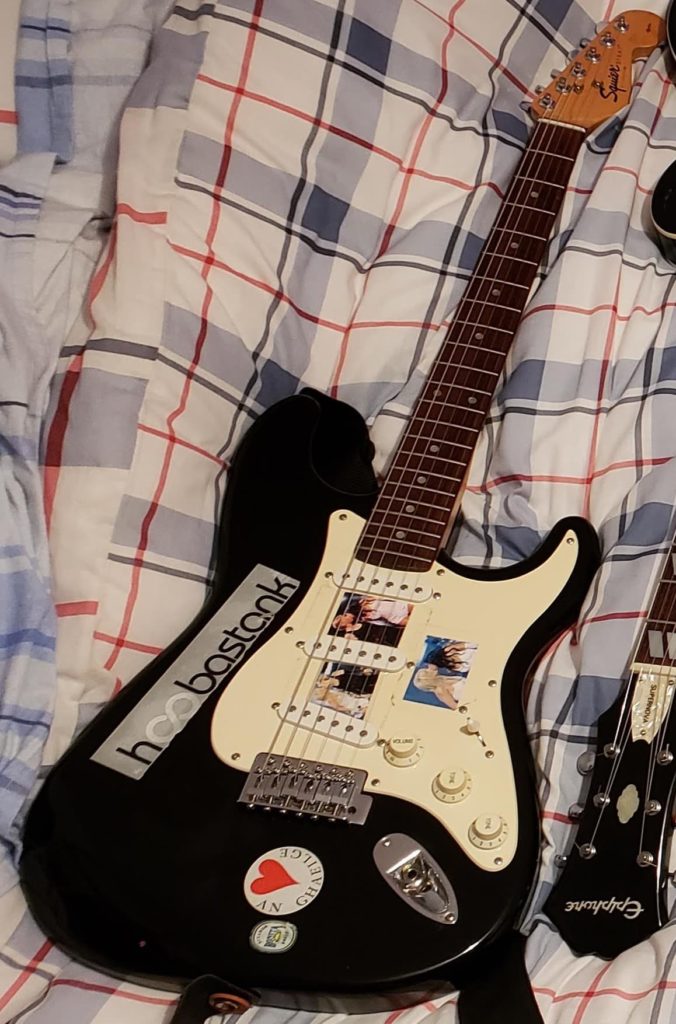
I was listening to The Verve’s Urban Hymns at the time, and I’d always wanted to write my own Champagne Supernova. I always liked the idea of making a proper epic, athemic song. My teenage self needed something to close out his headlining Glastonbury set with.
When I went to university. I wrote another song in my first couple of weeks there. When I came back to Castlebar for a weekend, I recorded it, The End, and another song I had.
It was a super-crude setup – just me singing into a radio cassette recorder while playing my Epiphone Supernova through my Marshall Valvestate VS102R behind me. I had precisely zero understanding of multitrack recording back then.
At the time, songwriters were told that to copyright their songs, they just had to record any kind of a version, and mail the cassette to themselves by registered mail, with the lyrics enclosed. So, that’s what I did. Then, that package I mailed to myself lived in the safe at my parents’ house.
Off the radar
And that was it. For almost 20 years.
I went to university, I worked, I moved to the UK, I started doing solo acoustic stuff, I started a band, I recorded and released albums and EPs and singles, I moved to New York, I started this website.
However, among all that, there was no record of The End. On occasion, I’d find myself picking that melody. Once when I was doing such picking, my wife heard it and said she liked it.
Although I never forgot about the song, I guess I never felt I had the capacity to deal with how epic I wanted it to be.
Revival
I had been working on Light Audio Recording for a year and a half I guess. You may or may not know, but I do actually plan the content – I don’t just write it on the fly and lash it out.
While I was planning content one day, I got a little worried that I’d run out of songs to write about recording. I hadn’t written a song in ages, likely because I was so busy writing about the songs I had.
So, I asked my parents if they’d retrieve the package from the safe. That would be at least three more songs to record and write about recording. They were able to bring it with them when they were coming over for my wedding.
Of course, it’s a cassette, and there is no cassette player in our home. But, I more or less remembered the music – it was the lyrics that I needed.
Then, I guess I got caught up with wedding, and honeymoon, and starting a new job, because I didn’t open it for another six months. Also, it was something I had for so long, I guess I was being nervous and precious about it. Finally, I opened the package in early December 2019.
Just opening the package and reviewing its contents was some kind of a wave of inspiration.
I finally had an idea for recording The End.
The idea
Because The End had been around for so long, stewing in my brain, I wanted it to reflect my musical journey.
I was going to put all of my guitars and basses on it. All 11 guitars and two basses. The ones at my parents’ house in Ireland, and the ones here in New York.
Essentially, twice as many guitars and basses as I normally put on a song.
That’s what makes this decision the first point of The End falling outside of light audio recording.
I was going back to my parents’ house for Christmas a few weeks after opening the package. And I think I’ve demonstrated how light and mobile my light audio recording setup is, so it would fit in my rucksack easily.
Recording The End
Recurring themes in recording The End
In the interest of brevity – because I assure you, this post is going to be plenty long enough – I’m going to get some things out of the way right here.
Certain things were identical in recording each section, so there’s no need to waste word count on repeating it for each one.
Recurring rig run down
This includes stuff that I didn’t use on every instrument section, but used whenever an instrument section that needed it occurred.
- Samsung Galaxy S9 smartphone
- BandLab Link Digital audio interface
- Beyerdynamic DT-240 PRO headphones
- Pig Hog 10ft XLR cable
- MXL V67G microphone
- Portastand Compact Mic Stand 2.0
- Samson PS01 pop shield
- Pig Hog instrument cables
- Dunlop Gator Grip 1.14mm picks
- Gator GPB-LAK-GR pedalboard
- Hotone Tuner
- Palmer BatPack 8000
- Audio Evolution Mobile for Android DAW app
Recurring setup
I always start a recording session by setting up my rig. In the case of The End, it was largely the same for every session, from scratch track to final vocals session.
- Firstly, I plugged the audio interface into my phone
- Then for guitars and vocals I plugged in a microphone, but for bass I plugged something directly into the audio interface
- I plugged in my headphones, so I could listen to what I was doing
- For guitars and vocals, I’d place the microphone where I wanted it
- For vocals I’d also attached a pop shield to the mic stand.
That was for every. Single. Session.
Recurring admin
Additionally, admin was the same for each section, largely probably because the gear was the same.
Ordinarily, I just bash out the scratch track in BandLab. But, at the time, BandLab would only record up to to six minutes. Without knowing exactly how long it was, I knew very well that The End was much longer than that…
If I recall correctly, it was easier to find alternatives in online DAWs to import samples, rather than record directly. So, I opted to record The End on the ever-reliable Audio Evolution, then export the samples into a more workable online DAW.
By and large, admin for recording The End was easier than usual, because Audio Evolution on my phone is more powerful than BandLab on my Chromebook, so I didn’t have to keep creating new projects.
However, it gets to a point where a lot of tracks on your phone screen is a pain to manage, so I created new projects for each country I recorded in.
Scratch track
Regardless, recording a song always starts with a scratch track. However, I honestly don’t remember anything about recording it! I swear I remember more about recording to cassette in 2001!
I seem to have simply recorded it into Audio Evolution with my phone. That’s only because I can’t find it anywhere else. While I normally go into great detail about my recording process, here’s the probable process for recording the scratch track.
Scratch track – recording
- Firstly, I would’ve sat with my metronome app to work out the tempo of the song – it turned out to be 75 BPM
- Secondly, I would’ve taken a level to record guitar – I think I used the Gibson ES-335 to get a “medium” tone
- I’d have tapped the record button, and played along to the metronome, while singing it in my head so the mic recording guitar wouldn’t pick up real vocals
- Next, I would’ve needed to record vocals; and what I probably did was:
- Lift the whole rig – phone, mic, mic stand – into the bathroom, with cables still attached
- Attach my pop shield
- Do a little more admin to add a track for vocals
- Take another level for my voice
- Tap record, and go for it
I don’t think I would’ve done too much in terms of mixing. I would’ve just exported it as a wav file, ready for recording drums…
Drums
I decided I didn’t want to have the intended massive wall of guitars ruined by my patchy drumming.
Drum machines and MIDI and that sound too fake. Getting somebody on BandLab’s Creative Connect to do it, or even Reddit or Craigslist, is too unpredictable in terms of both drumming and recording quality.
It was clear that I needed somebody who knew what they were doing, both in terms of drumming and recording.
With that in mind, I asked my friend, Rob Heath, if he could do it. I sent him the scratch track, explained what I was doing, and gave him Champagne Supernova and Come On as the points of reference. He said he was fan of both Oasis and The Verve.
And my good golly gosh: didn’t that just come across in what he recorded! They were absolutely the drums I imagined with this song when I wrote it 18 years before!
I wanted some additional cymbals at some points, and he had the revision back to me within a day.
Without doubt, it was the easiest drum recording I ever had! Rob also kindly added some tambourine and shaker.
But, it was also the second point of this project not strictly fitting into light audio recording, because I paid Rob. He’s a working musician. It’s his job.
Bass guitar in Ireland
Rob’s drums landed in my inbox when I was at my parents’. I had less than a week to record the bass and guitars that I had there.
The bass in question is a Vintage brand V4 – a Precision bass copy. I bought in the local music shop in Castlebar, for recording demos, in 2005 I think.
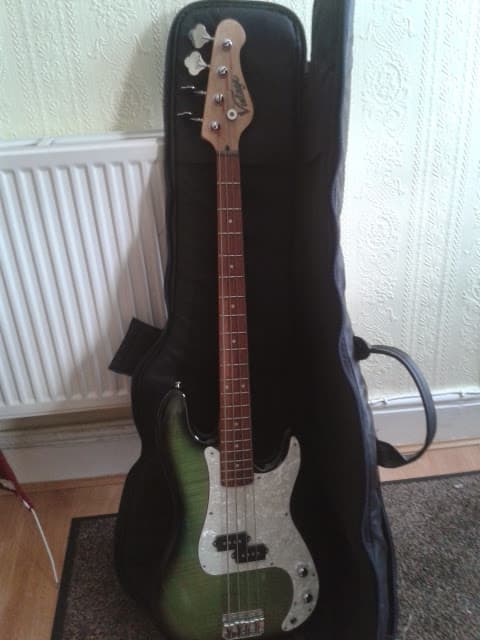
Recording this bass was super-straightforward:
- Bass plugged into audio interface
- Audio interface plugged into phone
- Headphones plugged into audio interface
Then, it was time for a little admin. In this case, that meant dowloading an MP3 of Rob’s mixed down drums from Google Drive on to my phone, and importing it to Audio Evolution. When that was done, I created a new track.
Finally, I took a level, tapped record, and away I went.
Although I had an idea in my head for a little slide in the chorus, I wasn’t able to play it the way it sounded in my head. So, I compromised with a super-simple alternative version. But I never really loved it.
Acoustic guitars in Ireland
However, I didn’t have time to dwell on the bass part I didn’t love. As mentioned, there was a relatively tight time budget!
The acoustic guitars in Ireland
I was excited because it was the first time I would be recording the very first guitar I owned: an acoustic guitar branded as Pro Session. I’ve never been able to find out anything about that brand. It came into my possession in 1996 or so, I guess.
The other acoustic guitar at my parents’ is an Encore electro-acoustic that I bought in Argos in Castlebar for €130 in September 2004. It was a cheapo for bringing to the Gaeltacht for a college trip. Following that, it became my main acoustic guitar, used for gigging, recording, and songwriting. We’ve had some adventures.
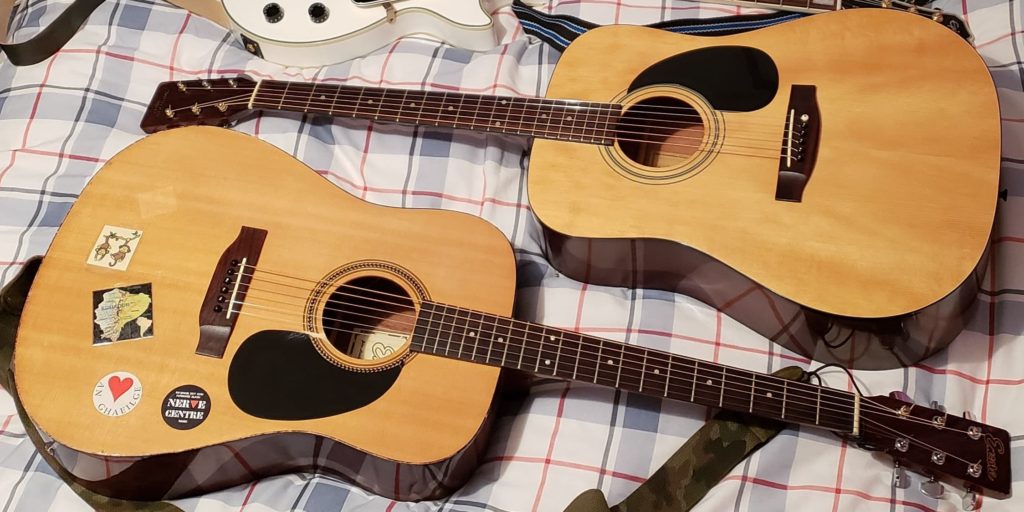
Acoustic guitars in Ireland – recording
I started trying to record the Pro Session in my sister’s bedroom, because Mrs. Light Audio Recording was still asleep. However, my sister’s bedroom is just next to mine, I was taking several takes, and I was keeping Mrs. Light Audio Recording from sleeping.
So, I picked up my gear, and moved to the library my parents converted their garage into. But Ma Light Audio Recording keeps a lot of Christmas stuff in there, so she was in and out.
Finally, I picked up all my gear and went to the summer house my parents have at the end of the garden. And let me tell you, that’s a cool environment to record in.
I recorded both acoustic guitars there, in my usual way, with the mic between six and eight inches away from the 12th fret of the guitar. I used the BOSS tuner app to tune the guitars before recording.
It was the same process for each guitar. Bish bash bosh. Done.
Electric guitars in Ireland
For recording electric guitars in Ireland, I needed my bedroom. I had no interest in lugging amps to the back of the garden. Also, my pedalboard was still in New York because of weight restrictions for bringing it on a plane. So was just going to be a simple guitar and amp affair.
The electric guitars and amps in Ireland
Notes about the electric guitars in Ireland
That Squier Strat was my first electric guitar and part of those starter packs that are still around. I got it around 1998. More importantly though, this was the guitar I wrote The End on. And this would be my first time recording it.
The Epiphone Supernova is the Noel Gallagher signature model. I got it in 2001. Oasis was the reason I started playing guitar and writing songs, so this was sought after for several years. It’s still a great instrument. And this would be my first time recording it since the aforementioned radio cassette recorder demo.
In 2004, I went into Walton’s in Dublin, and obsessed over an Epiphone Les Paul Standard Goldtop. They assured me that they always had one in stock. But, when I went to actually buy it with the money from my 21st birthday, they didn’t have it. And they couldn’t tell me when they’d have another one in. And they couldn’t give a single fuck. Wankers.
Anyhoo, I called my mam and she suggested getting something else from elsewhere. There was a small music store that I can’t remember the name of, on Wicklow Street or Exchequer Street. I was passing as I was on the phone. They had an Alpine White Epiphone Les Paul Custom in their window which had been catching my eye for a couple of months.
I went in, I played it, it was mine.
I used it for the first few years of Nerve Centre. As I recall, at the first Nerve Centre gig, a strap button came off in the middle of the set. It’s another guitar I’ve had some adventures with. I feel like I recorded some Nerve Centre songs with it, but I couldn’t tell you which ones.
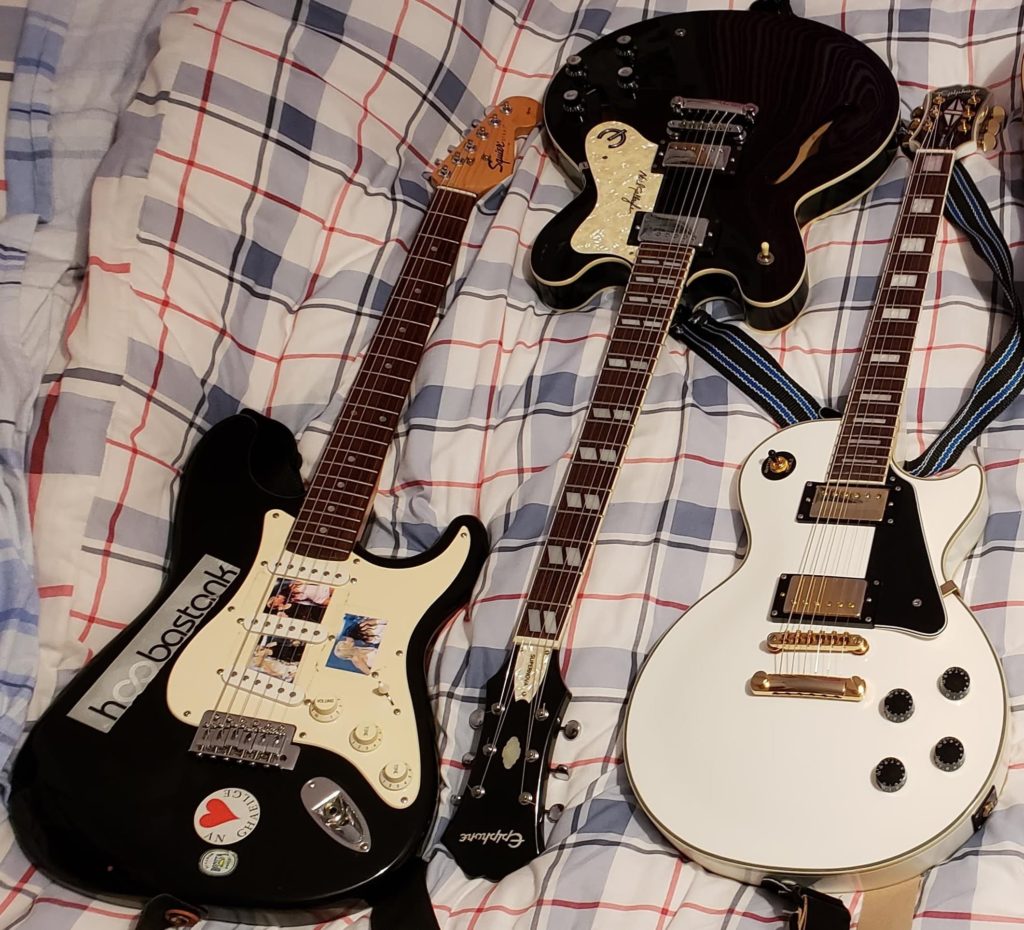
Notes about the guitar amps in Ireland
I had two amps to use and record in Castlebar.
Firstly, a Marshall VS102R. I got that when I was 17 with money from a part-time job. Actually, thinking about it now, it would’ve been just a few months before I wrote The End. In any case, I got this big beautiful beastie because I had every intention of starting a band. So we could play songs like The End and headline Glastonbury and close with The End.
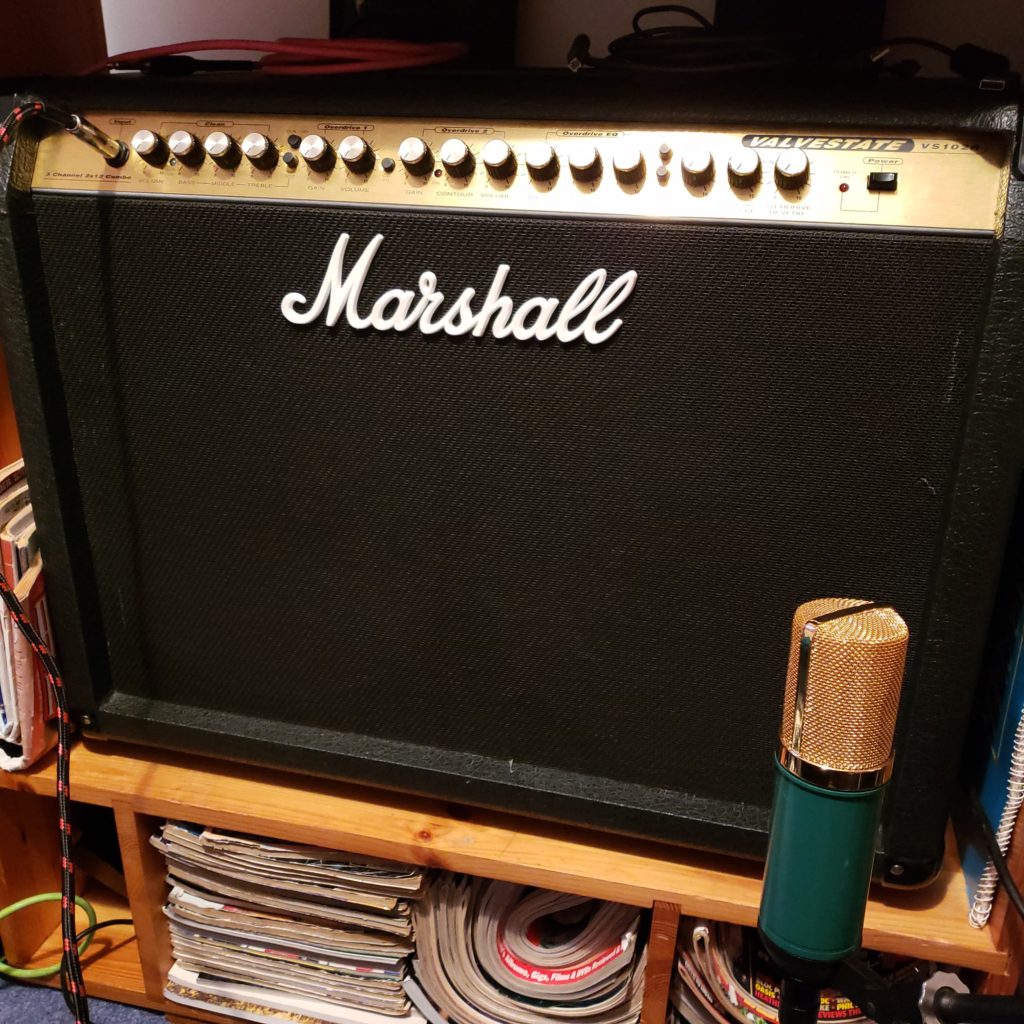
The Marshall has three channels: clean, and two overdrives. The first overdrive is relatively warm, whereas the second one is harsher. Playing what I play, the first overdrive is just right.
Ultimately though, I don’t think that amp has ever left my bedroom in my parents’ house.
The other amp is a Squier SP-10. It came in the Squier starter pack with the aforementioned Squier Strat. It’s a small little 10-watt practice amp with two channels – clean and dirty – with no control for the dirty channel. There’s no nuance to the distortion – it’s just on, and pretty harsh.
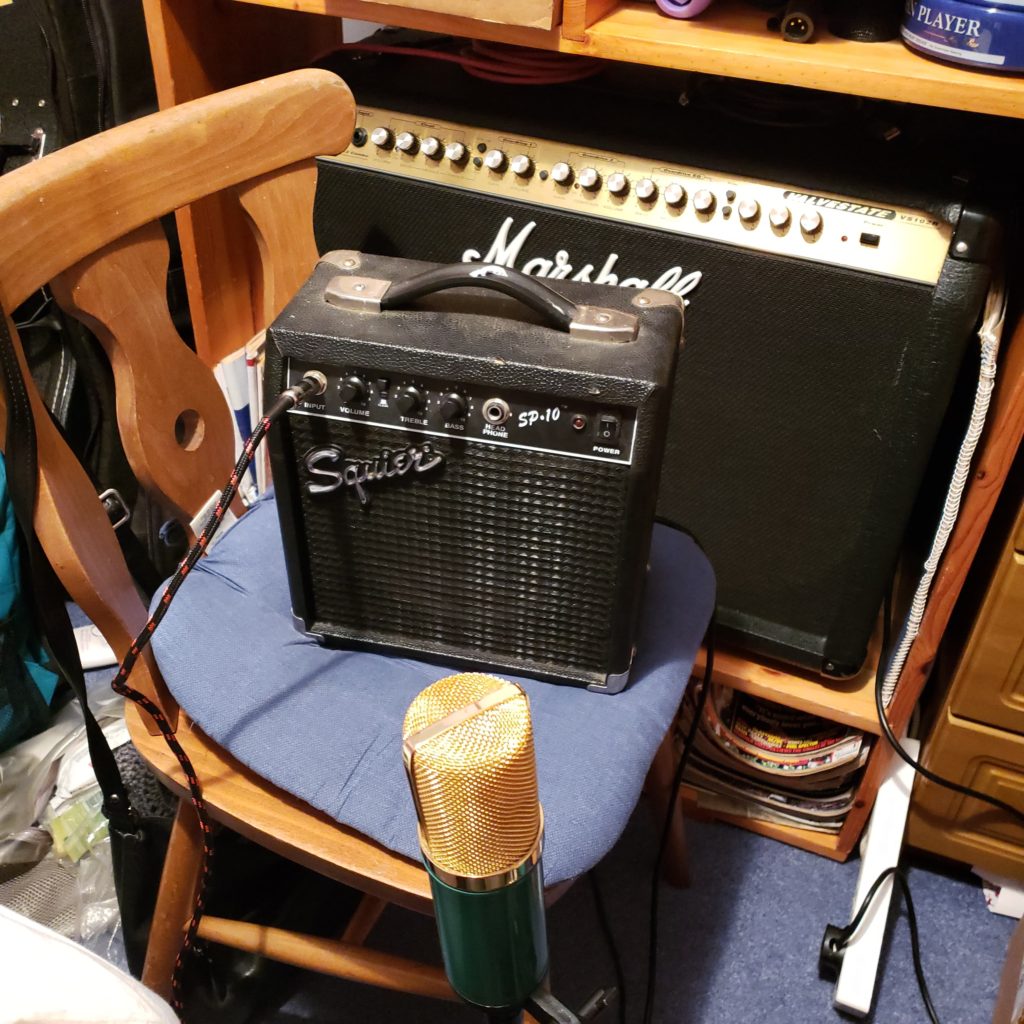
I used the very amp settings that I’ve used since reading James Dean Bradfield‘s amp settings in that bedroom when I was a teenager: bass at four, middle and treble each at six, and – on the Marshall anyway – the drive set to six.
Electric guitars in Ireland – recording
Same old, same old. Similarly to how I always record electric guitars, the different electric guitars in Ireland’s tones could be emphasized by playing them in different ways.
Before recording, I placed the mic about six inches or so from the front of the Marshall. The front of the mic pointed about halfway between the center and the circumference of the right-hand speaker cone.
Firstly, the Supernova, a semi-hollow with two humbuckers, so a nice bright but warm tone. Open chords all the way through for that, with both pickups selected.
Secondly, the Les Paul. That’s a solid mahogany body with two humbuckers. With both pickups on, playing power chords in the verses and open chords in the choruses, it’s a bit grungey. And that’s cool.
Then, the Strat. I used it to play the verse melody, and then just open chords on the chorus.
I’m not an emotional guitarist. Hell, with light audio recording, I’m just trying to get it done as efficiently as possible so I don’t bother the missus!
But this was different.
This was playing a guitar I’d owned since I was 15, through an amp I’d owned since I was 17, to record a song I wrote when I was 17 on said guitar and amp, now at the tender age of 36.
That’s wild.
I knew this was going to be a great epic song. I knew it when I was 17, and for all kinds of reasons, didn’t have the capacity to pull it off in a way that would do it justice until now.
Finally, it was the Strat through the Squier amp, to play barre chords on the choruses – what I normally play on my Fender Strat through the Smokey.
Bass guitar in New York
With everything tracked in Ireland, and Christmas and Hanukkah celebrated, it was back to New York, and time to record the other bass.
Firstly, I recorded the bass directly from the Laney’s output into the audio interface. I nailed it, but didn’t have time to listen back. But, when I did have time, it sounded nasty and distorted. So, I did it again… and had the same result.
Then, I got a new toy: the Behringer DI box. I scored it for $10 from a Craigslist ad. I needed to get another little XLR cable to make this work.
The output from the Laney was too much for the audio interface – that’s where the distortion came from.
The DI box has a button that dampens the audio signal by 20 dB. That give more control of said signal as it goes into the interface.
Third time lucky with the New York bass – I nailed it!
Remember earlier on when I said I wasn’t happy with the bass part I recorded in Ireland? Although I finally nailed the tone, the actual bass part still didn’t match what was in my head.
With some more tinkering, I got it close, but I still couldn’t get the little slide I wanted in between the root notes I needed.
Eventually, it dawned on me that I could record my little chorus slide separately… and hurrah! It finally sounded exactly how I wanted.
I didn’t delete that distorted one though. My penchant for a nice fuzzy bass has been noted in the past…
Acoustic guitars in New York
I can’t think of anything to write about the Epi and the Taylor, except I set up my rig and Audio Evolution, then sat in my living room. With my mic pointed at the 12th fret, I got a level, tapped record and got on with it.
I did that for each of them, I think in one sitting. No drama.
The C-1 took a little more. I think I recorded it in the bedroom. While I knew I wanted to double-track the core verse melody that I played on the Squier Strat through the Marshall, I knew it could bring more.
But I had no idea what it was. But, I started tinkering.
Eventually, I hit upon a very simple melody for the chorus, played on the top two strings. It was beautifully haunting, and driving at the same time. I tried to play something similar on the post-chorus… but the chorus part worked over it as well. It’s one of my favorite parts in the song.
I tried to do something with the C-1 on the outro as well, but it just wasn’t happening. And that was OK.
Bish bash bosh. Done.
Electric guitars in New York
- Dean USA Z
- Gibson ES-335
- Fender American Standard Stratocaster
- Laney VC15-110
- Zinky Smokey
- Ibanez Tube Screamer Mini
- Danelectro Tuna Melt tremolo pedal
- Morley Mini Wah
Recording the electric guitars was the most laborious part. There are just so many bits to it.
The rhythm sections were straightforward and easy enough. I stuck my mic in its usual spot, about six inches from the front of the Laney, pointing about halfway between the center and the circumference, took a level, and off I went.
As usual, I played open chords throughout on the 335; then power chords on the verse and open chords on the chorus with the Z.
Switching to the Smokey, I plugged in my Strat and placed the mic about six inches from the speaker. You can’t get too nuanced with such a tiny speaker. Again, it was very simple to just play barre chords on the choruses.
Lead guitar
The lead guitar though. A lot of it was figured out as I was about to record it. I had ideas, but hadn’t really played them out. I knew the outro needed a big solo, and I’m not much of a lead guitarist.
It took weeks to record this.
As always, my lead guitar sound was my Strat through my Laney, with some help from the Ibanez Tube Screamer Mini.
As I recall, the first things I recorded were the post-chorus licks. I also played a lick in the choruses, but when I listened back, they sucked. I played them each with and without the Tube Screamer.
Next, I think I tackled the solo in the middle. That took some work. I double-tracked it, and the bends in the second part of it were recorded separately so I could get to the widdling quick enough. The magic of recorded music! However, when I listened back, the bends were completely out of key. I needed to re-record them.
Then I had ideas for some more lead parts, but were actually played rhythm style. Firstly, single strums with my tremolo pedal engaged. That was just for the second and third verses and post-choruses: it’s a long song – I needed to do something to keep things interesting.
Secondly, strumming damped strings through a wah pedal. That was inspired by Rage Against The Machine. I read about it in Total Guitar when I was a nipper, and always loved the sound, but never did anything with it. I’ve always lamented the underuse of my wah pedal, so if it was going to be somewhere, it might as well be here. I regarded it as percussion part really.
Outro solo
If you’ve been following light audio recording, you know I’m not a shredder. My soloing is repetitive licks based on minor pentatonic scales.
But in my head, this ended with something far more grand. This would take work.
I left my wife to the TV in the living room, and holed up in the bedroom with my recording rig, Laney VC15-110, pedalboard, and Strat.
I was also in there with precisely zero idea where the hell to even start with this grand solo.
Before recording, I needed to get some vague semblance of what this would sound like. As I recall, I kind of just took a notion of playing sections of it at ascending points of the fretboard.
It took a lot of noodling before I even got in the ballpark. By the time I got there, my fingers were sore and trembling. Getting in the ballpark was the win for that session.
When I listened back, I heard what I needed to iron out.
It was a couple of days later when I again moved all I needed into the bedroom for a second session. It’s impossible to count the number of takes, but I had the solo I wanted.
Buuuuut… when I listened back a couple of days later, I still felt I could do better. The notes were all correct, but there was something not hanging about how I played it.
OK, one more session. Back in the living room while my wife was on a Zoom in the other room, I broke out my recording rig, and nailed it in a just a few takes.
Hurrah! All the instruments were tracked!
Vocals
Usually, the songs I sing are short, and the lyrics are delivered shortly and sharply.
The End is nothing like the songs I usually sing. It’s slow, long, and has a lot of notes being held for a bit.
Before recording vocals, I actually did some vocal warm up exercises. You really should do some before you ever sing anything at all. But, I’m usually in such a rush, just trying to get it done when I have a minute.
However, with The End, I wanted to make a little effort. A bajillion years ago when I lived in Birmingham, I went to an introductory vocal workshop that I got a Groupon for. As part of that, I received a CD with basic vocal warm-up exercises.
Now stored on Google Drive, I went through the exercises in the living room where I could crank them through my monitors. Then, I set up my rig in the bathroom, with the pop shield on my mic stand, and went for it.
I did three takes of the main vocals. If I recall correctly, I started over on a couple of them. Then, for backing vocals, I did…
- Some harmonies for the second half of every second line in the verse, à la The Verve’s Velvet Morning
- A bunch of “come on”s over the outro solo, à la The Verve’s Come On
- A couple of “ooh”s over the last chords, à la Champagne Supernova
The vocal performance was… as good as I could do.
But: The End was now completely tracked. Hurrah!
Editing The End
As can be seen, that’s a lot of different parts that got tracked.
As I tracked each part or instrument section, I wanted to be able to prepare them for mixing. So, editing them for any mistakes, and exporting them as raw stems.
But, I needed a DAW that wasn’t BandLab for that. After investigating a few online DAWs for importing the early tracks into, the only one that seemed to actually work was Spotify-owned Soundtrap.
Similarly to how I normally do when I work in Audio Evolution, I uploaded the samples to Google Drive, then downloaded them to my Chromebook. But, instead of importing them to BandLab, I imported them to Soundtrap.
Although technically, Soundtrap doesn’t have limits on song length or the number of tracks, at the end of the day, it’s in your browser. So, no more than BandLab, eventually it would start to lag. This meant that I had several projects on the go.
I edited each track according to Rob’s drums. Then I exported them as stems, and put them on Google Drive: that was their home, ready for mixing.
But, to give whoever mixed it an idea of what was in my head, I did a rough mix myself. During the rough mix, a couple of things got chopped because they just sounded bad: namely, the melody played throughout the choruses, the distorted bass, and the “come on”s over the outro solo.
You’ve heard the rough mix before, but here it is again.
Mixing The End
Throughout tracking The End, I went through many ideas for mixing it.
While I normally mix my little light audio recording efforts myself, between all the guitar and drum tracks, no online DAW would be able to handle that. And because I had paid for Rob’s drumming, I didn’t want to waste that, and all my guitars, on my rudimentary mixing skills.
Originally, I was thinking about getting one of my chums in the biz to do it.
But then I hit upon the idea of getting somebody who was involved in the recordings that inspired it to work on it.
Eventually, after reaching out to some people, between one thing and another, I worked with Chris Potter, who mixed Urban Hymns.
In case you’re wondering what it takes to be able to work with a mixing engineer of this caliber, let me break it down into three easy steps.
- Google to find out how to reach them
- Ask their management company about it
- Pay them
After some perfectly pleasant and short back and forth about cost, they named a price that was more than I had budgeted for, but not impossibly expensive. After discussing the matter with my wife and my teenage self, and listening to Urban Hymns, and knowing that I would never be able to do this again… I went for it.
How much was it? Aw wow! I’m so excited that you’ve read this far. I really appreciate it so much, I really do. But unfortunately, how much I paid Chris Potter is none of your business.
Paying somebody else to mix it is the third point of this being beyond the scope of light audio recording.
Working with Chris Potter
Chris started working on it on a Monday, and had a version over to me by that Friday. I spent the weekend listening to it on every device, speaker, and headphone that I owned. Overall, it was mega. It was right in the ballpark of what I had in my head when I wrote it.
But, a couple of things weren’t quite landing for me. I told him what I heard and what I’d like, and he had a new mix over to me in a couple of days.
It was all completely straightforward. Because that’s business.
Mastering The End
While I had nailed a great connection to Come On, I also wanted a connection to Champagne Supernova. Wikipedia said Barry Grint mastered Morning Glory.
As Chris finalized the mixing, I Googled Barry to find out how if he was still mastering, and how to reach him. I was able to email him directly, and it was pretty much resolved that he would master The End within about an hour of short, polite back and forth.
Paying for mastering is the fourth point of The End being beyond the scope of light audio recording.
He had it for me in a couple of days, telling me it was quite guitar-forward, similar to what he did with Oasis at Abbey Road.
I mean, c’mon… what on earth else did I want to hear?
Well, I wanted to listen to the track. I listened through big speakers and little speakers. I was just like… holy shit… it’s there. After 19 years, it’s there. This is what’s been stewing in my brain and now it’s out, and people are going to hear it.
It was a very proud, very surreal nine and a half minutes.
Releasing The End
Now that The End existed in its intended form outside of my head, what next for it?
It’s too long for strangers to give a shit about, especially now.
- The idea of an intro on a song is dated
- Kids don’t have the attention span to listen to a full song of any length
- The point where they skip a track is just before the guitar solo
At the same time, I’m incredibly proud of this track. I wanted it out in the world to at least give people the option of listening to it.
How’s the world gonna take me?
I went on Amuse and sent it for release, with a picture from my wedding as the cover art.
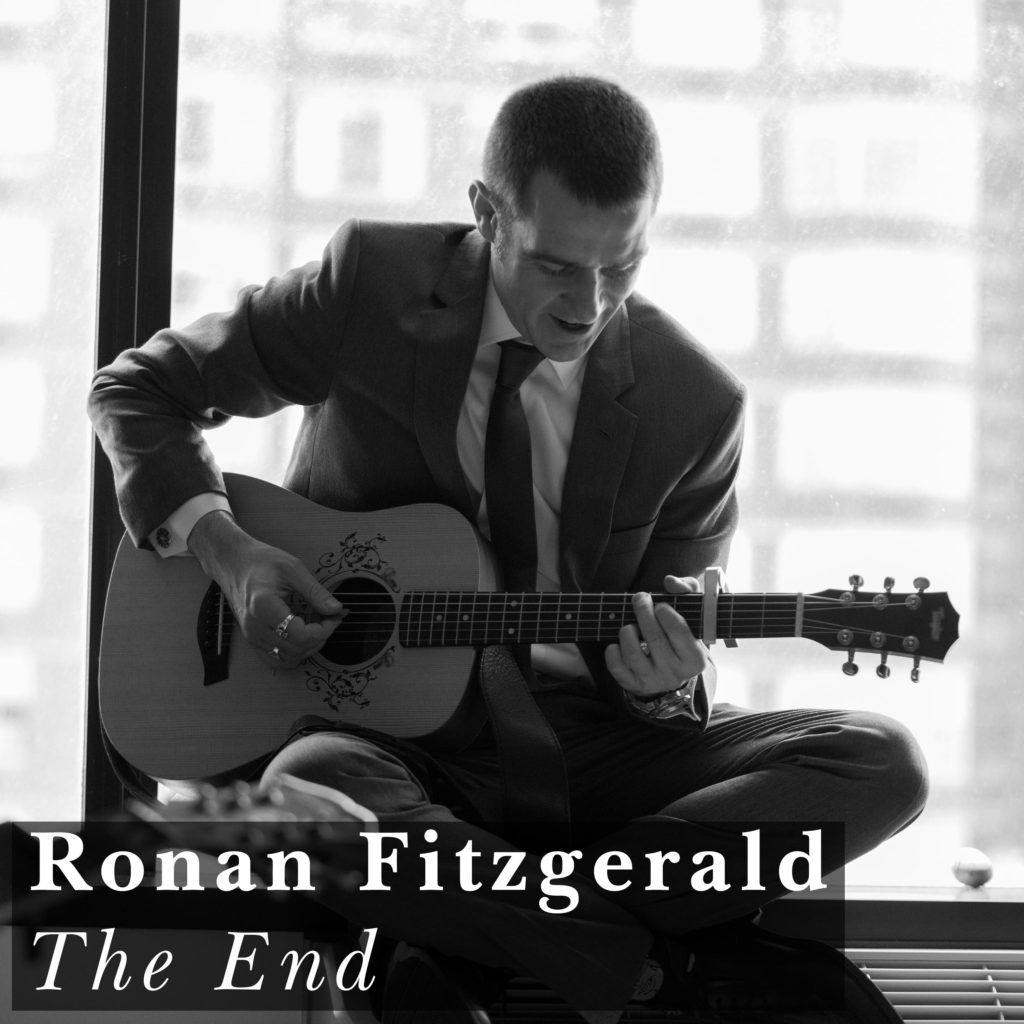
It came out on July 4th, 2020.
Despite releasing music for 12 years now, this’ll be the first time I release something under my own real name. Like, I recorded my earliest demos and did my pre-Nerve Centre acoustic stuff under my own name, but none of that was ever “released.”
Nerve Centre’s recordings were released as Nerve Centre. And when I came back from Costa Rica, amidst the rise of UKIP in the UK, I released music under The Dirty Immigrant moniker. Then there were more sporadic Nerve Centre releases. Then I moved to New York, and released light audio recording under Light Audio Recording.
Apart from performing everything except drums, with this release taking in a little bit of everything of my musical journey to date, that makes it feel like the most “Ronan Fitzgerald” recording possible. So, why not use my own name?
Additionally, I pitched it to friends of mine who have a publishing company. Things set in the 90s are hot right now – Captain Marvel, Little Fires Everywhere, Derry Girls, the Jagged Little Pill musical.
I thought a song that’s of the era, but not a massive hit, might be useful for projects set in the era that don’t have the budget to use a massive hit.
Conclusion
To conclude, here’s the damn track that I’ve been bleating on about.
Here are some final thoughts.
Firstly, it’s a relief to finally have this out of my system. My teenage self is chuffed to bits. It’s exactly what it’s supposed to sound like. I don’t think I’ve ever completely had that before.
Secondly, I’m very conscious of my privilege in doing this. Seriously: 11 guitars, two basses, and paying for Rob, Chris, and Barry. It’s like boom! A total privilege bomb.
Thirdly, I’m reflective about the 19 years it’s taken to record it. I’m glad I took my time. I didn’t have the confidence to pull it off musically before. I don’t know why I was confident now. It’s also the first time I felt financially confident.
But in saying that, I won’t be doing this again. This was a one-off.
Related to that is the amount of things it takes in. From my spotty face listening to Oasis and The Verve with aspirations of rock ‘n’ roll superstardom, to playing cheap guitars and amps in Castlebar. From what I learned from Trev at Circle Studios when I lived in the UK, to upgrading my gear over the years. And finally, from the elaborate home recordings and developing an ear for arranging songs, to developing light audio recording here in New York.
That last paragraph is everything The End draws on.
There you have it. This is the end of The End. If you listened to it all, I hope you think the song is OK.
Thanks for reading and listening.
The End: credits
Written by: Ronan Fitzgerald
Guitars, bass, vocals: Ronan Fitzgerald
Drums: Rob Heath
Mixed by Chris Potter for Z Management
Mastered by Barry Grint at Alchemy Mastering
Cover photo by Mariana Martinis for Keep It Captured Photography